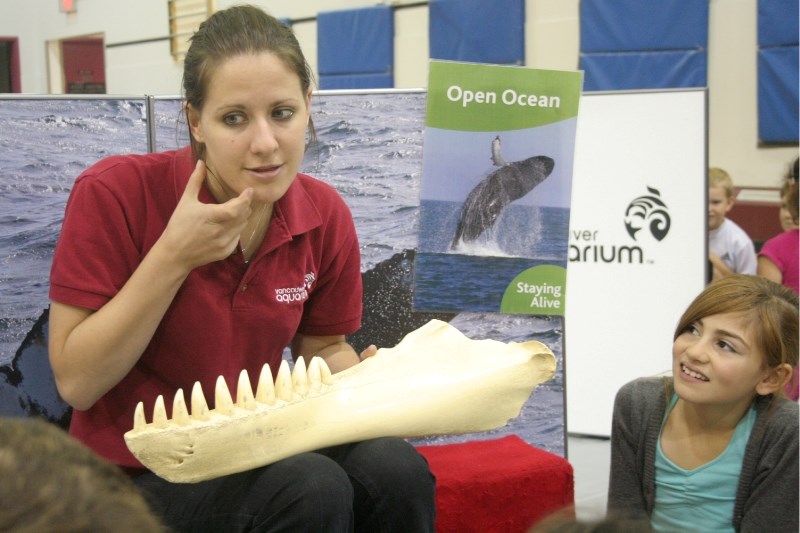A smiling young woman lifted a squirming male Dungeness crab out of a plastic bucket to gasps and giggles from the collected audience. This crab’s body was about the size of a grapefruit, but she said that the Japanese spider crab can have a leg-span of up to 12 feet.
Grade four students learned all sorts of fishy facts like that and more when the Central Elementary gym hosted the Vancouver Aquarium’s AquaVan program last Tuesday. Knowledgeable staff entertained and enlightened the kids by letting them see and touch everything from arthropods, starfish, urchins, flat fish, and even bits and pieces of sharks and whales.
“It’s about learning about conservation and creating future stewards for our oceans,” said program coordinator Leilani Dallin. “And it’s to just introduce these kids to something new.”
AquaVan, now in its 18th year, travels to schools in Alberta and British Columbia with their collection of wetlands and ocean animals that can be found around the BC coast. The theme for this year is “Staying Alive,” and features creatures from four habitats - salt marsh, seashore, open ocean, and kelp forest - all in an effort to explain to students humanity’s place in the delicate coastal ecosystem.
Ms. Jackie Routhier’s class was split into small groups who learned about each of the four different habitats. They got the chance to get to feel a starfish’s nubby belly, poke a shy sea slug in its shell, and gawk at a flat fish that has two eyes on one side of its face.
In the open ocean section, kids sat in rapt attention as they learned that a blue whale’s tongue weighs as much as an adult elephant. Then they saw an actual piece of baleen - the comb-like filters used to collect plankton and krill - from the massive mammal’s mouth and a cast of a killer whale’s jawbone.
After being shown the toothy grin of a bull shark’s mouth, the students learned that while sharks kill only five people on average annually, humans are responsible for the deaths of 40 million sharks a year – much of it for shark fin soup.
An otter pelt, hermit crabs, and some live sea urchins were the props for the kelp forest area, where the AquaVan worker explained how the balance between the predator (the otter) and the prey (urchins) benefited the whole ecosystem. Those relationships were repeatedly stressed to the youngsters.
“It supports two really important pillars for us: education and spreading the message of the importance of looking after the environment,” said Ruth Christensen who works for Cenovus, a major sponsor of the program. “As presenting sponsor, we were able to specify the communities we want the AquaVan to visit, so of course Lac La Biche was on the list.”
Dallin estimates that around 1,500 young students will have the chance to experience and learn about the aquatic creatures that make up the West Coast ecosystem. One thing all the students learn about is how even though they may live thousands of kilometres from the coast, they can still harm it with their litter.
The Great Pacific Garbage Patch, she explained, is a massive collection of plastic and other waste that is collected by ocean currents to make a floating trash patch in the central North Pacific Ocean. Dallin asked the students to guess how big the Great Pacific Garbage Patch is, with all of the estimates falling way short of the actual size, which is the combined area of Alberta and Saskatchewan and half a kilometre deep in parts.
“We have a huge effect on the lives of the animals around us,” Dallin told the students after they’d seen the sea creatures and exhibits. “So when you see litter — throw it in the garbage. Or better yet, try to reduce, reuse, and recycle; because even though you’re a long way from the ocean, trash can travel from lakes to rivers to the ocean and harm the animals that live there.”



